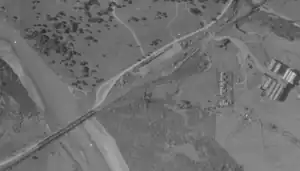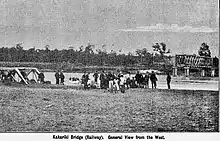Kakariki railway station
Kakariki railway station was a station on the North Island Main Trunk and in the Manawatū-Whanganui region of New Zealand .[2][3]
Kakariki railway station | |||||||||||
|---|---|---|---|---|---|---|---|---|---|---|---|
 Kakariki railway station and bridge in 1942 | |||||||||||
| General information | |||||||||||
| Location | New Zealand | ||||||||||
| Coordinates | 40.125543°S 175.446466°E | ||||||||||
| Elevation | 70 m (230 ft) | ||||||||||
| Line(s) | North Island Main Trunk | ||||||||||
| Distance | Wellington 171.21 km (106.38 mi) | ||||||||||
| History | |||||||||||
| Opened | 1879[1] | ||||||||||
| Closed | 31 January 1982[1] | ||||||||||
| Electrified | June 1988 | ||||||||||
| Services | |||||||||||
| |||||||||||
It opened in 1879 and closed in 1982.[4] Only a single track now runs through the station site,[5] as the passing loops here and at Halcombe were replaced by the Rangitawa loop, 2.55 km (1.58 mi) to the south,[6] on 14 December 1983.[4] The new loop is beside Halcombe Road.[7]
A 2008 Ministry of Transport "National Freight Demands Study" said, "Current thinking includes . . . a deviation from Kakariki to Porewa to avoid the steep grades into Marton".[8] A Porewa valley line would be about 7 km (4.3 mi) long and shorten the NIMT by around 10 km (6.2 mi).[9]
History
Locket and & Co built the Rangitīkei River bridge and railway from Turakina to Kakariki in 1877, as part of a railway linking the ports of Foxton and Whanganui. Nathan & Wilkie built the Kakariki to Feilding part of the line.[10]
Kakariki wasn't shown on the timetable when the line opened in 1878.[11] In 1878 it was recommended that Kakariki should have a goods shed and loading stage.[12] It was shown in a fare table in 1883.[13] By 1892 Kakariki had a shelter shed, passenger platform, cart approach to the platform, loading bank, crane and a passing loop for 8 wagons. The crane was removed in 1905. By 12 January 1933 it had a ladies waiting room, which caught fire that morning. The station yard was rebuilt in 1940, after the new bridge opened.[12]
A station building and loop for 18 wagons remained in 1980. Kakariki closed to all but private siding traffic on Sunday 31 January 1982. In 1989 it was reported the wool store siding was derelict, but in 1991 it had two wool sidings.[12]
In 1932 fourteen wagons were derailed at the station, when an axle broke.[14]
Ballast pit
In 1889 an urgent want of ballast land at Kakariki was described and by 1892 there was a ballast siding 1⁄4 mi (0.40 km) north of the station.[12] The ballast pits either side of the river, which excavated river shingle, seem to have been mainly named Kakariki, but also Greatford.[15]

Kakariki Bridges
The railway crosses the Rangitīkei River on a truss bridge[16] with five 120 ft (37 m) spans and a 40 ft (12 m) abutment,[17] built in 1939. The piers are 46 ft (14 m) to 54 ft (16 m) deep.[18] Just upstream is a 1968,[19] or 1970, bridge carrying Halcombe Road.[20]
The original rail bridge was built in 1877.[10] Three spans of the bridge were washed away in June 1882.[21] The 1882 temporary bridge included 30 tons of cylinders[22] and wooden piles.[23] It was back in use in August 1882.[24] A permanent replacement was being built in October 1882[25] and completed in June 1883.[26] The railway bridge was swept away again in 1897.[27] It was converted to a road rail bridge[28] from 5 March 1900.[29] A loose beam on the bridge hit a train in 1933.[30]

In 1939 the road rail bridge became a road only bridge, when the present railway bridge was built. That former rail bridge was demolished in 1970.[31]
Deviation
To ease the climb to Halcombe from 1 in 53 to 1 in 70,[32] a deviation was built in 1915, with a new girder bridge over Rangitawa Stream and a 3 span 60 ft (18 m), reinforced concrete bridge carrying Halcombe Road over a new 30 ft (9.1 m) deep cutting.[33]
Factory
The factory at Kakariki has had a variety of uses. A sawmill closed in 1879, when the bush had been felled.[34] Work started on a flaxmill about 1882.[35] By 1889 flax was being railed from Kakariki to Feilding.[36]
The Wellington Meat Export Co freezing works had a siding from 2 April 1917[12] and had three sidings when it opened in 1918.[37] The works was said to have brought the company close to bankruptcy[38] and it closed in 1923,[39] though it was mentioned as in use in 1924.[40] The machinery was removed in 1935.[41] In the 1940s it was used for Air Force storage.[42] From 1945, it was used for cool wool storage, having been re-equipped in 1940[43] for dairy products, with freezers from the Port Bowen, wrecked at Castlecliff in 1939.[44]
In 1948 Feltex converted the factory to a wool scour plant using machinery moved from Melbourne; the then Managing Director owned a nearby farm.[45] In 1980 the Feltex siding could hold 18 wagons.[12] According to its later much litigated prospectus,[46] the Kakariki plant employed 47 in 2004.[47] In 2006 Feltex went into receivership. Godfrey Hirst took over and closed the plant.[45]
In 2007 the site was sold to Kakariki Industrial Park.[48] It is now part leased to Kakariki Proteins as a rendering plant[49] to produce animal feed.[50] In 2019 the site was identified as a potential source of per- and poly-fluoroalkyl contamination of the Bulls water supply.[51] A 1940s report had said, “There is ample water available from wells sunk on the banks of the Rangitiki River and drainage into the Rangitiki River basin is assured for the disposal of industrial effluents.” Most of the 1918 works remains, except that the brick chimney has been replaced by a metal one.[52]
St Joseph's church
1.7 km (1.1 mi) east of the station[53] is the small Catholic church of St Joseph, built on Te Hiri Marae in 1914 for Ngāti Rangatahi and designed by John Swan. It was registered by Heritage New Zealand as a Category 2 heritage item, with registration number 7188 on 23 June 1994.[54]
Just beyond the church,[55] a school opened between 1898[56] and 1899.[57] It closed[58] in the 1970s.[55]
References
- Names & Opening & Closing Dates of Railway Stations in New Zealand by Juliet Scoble (2012)
- New Zealand Railway and Tramway Atlas (First ed.). Quail Map Co. 1965. pp. 3 & 4.
- Pierre, Bill (1981). North Island Main Trunk. Wellington: A.H&A.W Reed. pp. 289–290. ISBN 0589013165.
- Juliet Scoble: Names & Opening & Closing Dates of Railway Stations in New Zealand
- "1599 Halcombe Rd". Google Maps. June 2019. Retrieved 30 January 2021.
- New Zealand Railway and Tramway Atlas (First ed.). Quail Map Co. 1965. pp. 3 & 4.
- "1309 Halcombe Rd". Google Maps. June 2019. Retrieved 30 January 2021.
- "national-freight-demands-study-ministry-of-transport". yumpu.com. 2008. Retrieved 30 January 2021.
- "New Zealand Topographic Map". NZ Topo Map. Retrieved 30 January 2021.
- "MARTON. NEW ZEALAND TIMES". paperspast.natlib.govt.nz. 27 July 1877. Retrieved 1 February 2021.
- "WANGANUI-MANAWATU RAILWAY. TIME TABLE. NEW ZEALAND MAIL". paperspast.natlib.govt.nz. 1 June 1878. Retrieved 31 January 2021.
- "Stations" (PDF). NZR Rolling Stock Lists. Retrieved 10 August 2020.
- "RAILWAY FARES FROM THE FEILDING STATION. FEILDING STAR". paperspast.natlib.govt.nz. 17 March 1883. Retrieved 31 January 2021.
- "KAKARIKI DERAILMENT. MANAWATU STANDARD". paperspast.natlib.govt.nz. 23 July 1932. Retrieved 6 February 2021.
- "GREATFORD GRAVEL PIT. WANGANUI CHRONICLE". paperspast.natlib.govt.nz. 9 March 1915. Retrieved 29 January 2021.
- "Reconstruction of Rangitikei Bridge - Kakariki - General Elevation". archivescentral.org.nz. 1934. Retrieved 1 February 2021.
- "Railway Bridge to Become Road Bridge MANAWATU TIMES". paperspast.natlib.govt.nz. 29 June 1938. Retrieved 1 February 2021.
- "RAILWAY BRIDGE TO BECOME ROAD BRIDGE. HOROWHENUA CHRONICLE". paperspast.natlib.govt.nz. 29 June 1938. Retrieved 1 February 2021.
- "Roading Activity Management Plan 2021-2024" (PDF). Manawatu District Council.
- "Bridges: Kakariki Bridge Renewal - Locality and Site Plan | Archives Central". archivescentral.org.nz. 1967. Retrieved 1 February 2021.
- "DESTRUCTIVE FLOODS. WANGANUI HERALD". paperspast.natlib.govt.nz. 10 June 1882. Retrieved 31 January 2021.
- "LOCAL AND GENERAL. FEILDING STAR". paperspast.natlib.govt.nz. 9 August 1882. Retrieved 31 January 2021.
- "LOCAL AND GENERAL. FEILDING STAR". paperspast.natlib.govt.nz. 17 June 1882. Retrieved 31 January 2021.
- "WANGANUI HERALD". paperspast.natlib.govt.nz. 24 August 1882. Retrieved 31 January 2021.
- "LOCAL AND GENERAL. FEILDING STAR". paperspast.natlib.govt.nz. 7 October 1882. Retrieved 31 January 2021.
- "Local & General News. FEILDING STAR". paperspast.natlib.govt.nz. 23 June 1883. Retrieved 31 January 2021.
- "THE FLOODS IN THE RANGITIKEI. WANGANUI CHRONICLE". paperspast.natlib.govt.nz. 21 April 1897. Retrieved 1 February 2021.
- "Local and General News. FEILDING STAR". paperspast.natlib.govt.nz. 5 March 1900. Retrieved 1 February 2021.
- "Local and General News. FEILDING STAR". paperspast.natlib.govt.nz. 2 March 1900. Retrieved 5 February 2021.
- "MISHAP ON BRIDGE. HAWERA STAR". paperspast.natlib.govt.nz. 18 May 1933. Retrieved 6 February 2021.
- "Rangitikei River Bridge". www.feildingheritage.nz. Retrieved 1 February 2021.
- Pierre 1981, p. 138,146.
- "KAKARIKI RAILWAY IMPROVEMENTS. WANGANUI CHRONICLE". paperspast.natlib.govt.nz. 29 September 1915. Retrieved 30 January 2021.
- "LOCAL INTELLIGENCE. MANAWATU TIMES". paperspast.natlib.govt.nz. 4 October 1879. Retrieved 31 January 2021.
- "NEWS IN BRIEF. NEW ZEALAND HERALD". paperspast.natlib.govt.nz. 8 February 1881. Retrieved 31 January 2021.
- "Local and General News FEILDING STAR". paperspast.natlib.govt.nz. 9 July 1889. Retrieved 4 February 2021.
- "WELLINGTON MEAT EXPORT CO. RANGITIKEI ADVOCATE AND MANAWATU ARGUS". paperspast.natlib.govt.nz. 25 April 1918. Retrieved 5 February 2021.
- "FREEZING MERGER COMPLETE. HOROWHENUA CHRONICLE". paperspast.natlib.govt.nz. 21 May 1927. Retrieved 6 February 2021.
- "CLOSED DOWN. MANAWATU TIMES". paperspast.natlib.govt.nz. 19 January 1923. Retrieved 5 February 2021.
- "A BUSY STATION. PAHIATUA HERALD". paperspast.natlib.govt.nz. 17 December 1924. Retrieved 5 February 2021.
- "Kakariki. MANAWATU TIMES". paperspast.natlib.govt.nz. 1 May 1935. Retrieved 6 February 2021.
- "STORAGE FOR WOOL. MANAWATU STANDARD". paperspast.natlib.govt.nz. 12 October 1944. Retrieved 6 February 2021.
- "Old Kakariki Freezing Works MANAWATU TIMES". paperspast.natlib.govt.nz. 27 September 1940. Retrieved 6 February 2021.
- "Potato Shortage. MANAWATU STANDARD". paperspast.natlib.govt.nz. 23 August 1945. Retrieved 5 February 2021.
- "site of factory". wikimapia.org. Retrieved 30 January 2021.
- "Feltex shareholder compensation case struck out". Stuff. 11 December 2020. Retrieved 31 January 2021.
- "Feltex Carpets Limited Investment Statement and Prospectus" (PDF). 5 May 2004.
- "Decision 200710029 - Kakariki Equities Limited and Foxton Equities Limited". Land Information New Zealand (LINZ). Retrieved 30 January 2021.
- "Kakariki". www.feildingheritage.nz. Retrieved 1 February 2021.
- "Millions lost after warm seas kill salmon". Stuff. 12 March 2015. Retrieved 1 February 2021.
- "Bulls Water Supply PFAS Investigation" (PDF). Horizons Regional Council. 9 October 2019.
- "1599 Halcombe Rd". Google Maps. Retrieved 6 February 2021.
- "Halcombe to Pryces Line". Google maps. Retrieved 2 February 2021.
- "St Josephs Church". www.heritage.org.nz. Retrieved 2 February 2021.
- "1:63360 map - Marton Sheet: N143". www.mapspast.org.nz. 1975. Retrieved 4 February 2021.
- "PAHIATUA HERALD". paperspast.natlib.govt.nz. 12 October 1898. Retrieved 5 February 2021.
- "Local and General News. FEILDING STAR". paperspast.natlib.govt.nz. 30 March 1899. Retrieved 4 February 2021.
- "Halcombe History". Retrieved 4 February 2021.
External links
- photo of the flood-damaged bridge - probably 1897
- 1932 photos of derailment a mile south of Kakariki
- 1940 photo of freezing works
- 1975 aerial photo of station and factory
- 2013 and 2014 videos of freight trains crossing the bridge
- 2021 video of steam train on bridge (at end of video)
- photo of church